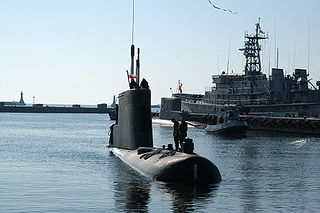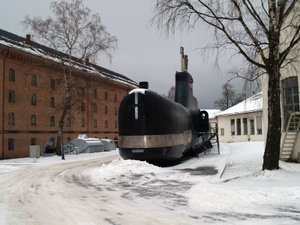
The Royal Norwegian Navy is the branch of the Norwegian Armed Forces responsible for naval operations of Norway. As of 2008, the Royal Norwegian Navy consists of approximately 3,700 personnel and 70 vessels, including 4 heavy frigates, 6 submarines, 14 patrol boats, 4 minesweepers, 4 minehunters, 1 mine detection vessel, 4 support vessels and 2 training vessels. It also includes the Coast Guard.

The Type 212A is a class of diesel-electric submarine developed by Howaldtswerke-Deutsche Werft AG (HDW) for the German Navy, and the Italian Navy where it is known as the Todaro class. It features diesel propulsion and an additional air-independent propulsion (AIP) system using Siemens proton-exchange membrane (PEM) compressed hydrogen fuel cells. The submarines can operate at high speed on diesel power or switch to the AIP system for silent slow cruising, staying submerged for up to three weeks with little exhaust heat. The system is also said to be vibration-free and virtually undetectable.

HDMS Sælen (S323) is one of the three Tumleren-class small coastal submarines of the Royal Danish Navy.

The Royal Danish Navy is the sea-based branch of the Danish Defence force. The RDN is mainly responsible for maritime defence and maintaining the sovereignty of Danish territorial waters. Other tasks include surveillance, search and rescue, icebreaking, oil spill recovery and prevention as well as contributions to international tasks and forces.

The Delfinen-class submarines were the first class of submarines constructed for the Royal Danish Navy following World War II. They were designed and built within Denmark, with first three boats of the class financed by Denmark. The fourth was financed by the United States under the Cost Share program. Constructed between 1956 and 1963, the class comprising four submarines entered service in 1961 and the last taken out of service in 1990. Replaced by the Norwegian Kobben class, three of them were scrapped while a fourth was converted into a museum ship and remains on display at the Aalborg Maritime Museum.

The Ula class is a Norwegian submarine type which was assembled in Germany in the late 1980s and early 1990s. The class, consisting of six vessels, is currently the only submarine type in service with the Royal Norwegian Navy.

Whiskey-class submarines are a class of diesel-electric attack submarines that the Soviet Union built in the early Cold War period.

ORP Sokół, formerly HNoMS Stord, is one of four Kobben-class submarines of the Polish Navy. The vessel was built by Rheinstahl Nordseewerke GmbH in Emden, Germany for the Royal Norwegian Navy as HNoMS Stord. The vessel served with the Royal Norwegian Navy from 1967 until it was given to Poland in 2002. Sokół was modified in Gdańsk after the handover. The ship was decommissioned on 8 June 2018. In the same year, he joined the program about converting a ship into a museum ship. In July 2020, work began on the unit in order to prepare it for museum functions.

ORP Bielik, formerly HNoMS Svenner (S309), is one of four Kobben-class submarines in service with the Polish Navy. The vessel and its sister ships were built in the period 1964–1967 by Rheinstahl Nordseewerke GmbH in Emden, West Germany for the Royal Norwegian Navy. The Kobben-class submarines were given to Poland in the 2002–2004 period after having been replaced by Ula-class submarines in Norway. Before entering active Polish service the boat was modified in Gdańsk.

The Type 206 is a class of diesel-electric submarines (U-boats) developed by Howaldtswerke-Deutsche Werft (HDW). Its design is based on the preceding Type 205 submarine class. These small and agile submarines were built during the Cold War to operate in the shallow Baltic Sea and attack Warsaw Pact shipping in the event of military confrontation. The pressure hulls were built out of non-magnetic steel to counter the threat of magnetic naval mines and make detection with MAD sensors more difficult. The low emission profile allowed the submarines in exercises to intrude even into well-protected opposing forces such as carrier formations with their screen.

The Type 205 was a class of German diesel-electric submarines. They were single-hull vessels optimized for the use in the shallow Baltic Sea. The Type 205 is a direct evolution of the Type 201 class with lengthened hull, new machinery and sensors. The biggest difference though is that ST-52 steel is used for the pressure hull since the Type 201's non-magnetic steel proved to be problematic. Type 206, the follow-on class, finally succeeded with non-magnetic steel hulls.

Nordseewerke Emden GmbH was a shipbuilding company, located in the Emden Harbor of the north German city of Emden. Founded in 1903, shipbuilding ended in 2010, and the company was taken over by the Schaaf Industrie AG, which among other products, makes components for off-shore systems.
HNoMS Utvær (S303) may refer to one of the following submarines of the Royal Norwegian Navy:
HNoMS Uthaug (S304) may refer to one of the following submarines of the Royal Norwegian Navy:

ORP Sęp was an Orzeł-class submarine serving in the Polish Navy during World War II. In Polish her name means Vulture.
HNoMS Utstein is a series of three submarines operated by the Royal Norwegian Navy. They were named after a historic Utstein Abbey which is located on the island of Klosterøy in Rennesøy, Norway. The three submarines that have borne this name are:

The Polish Navy is the naval branch of the Polish Armed Forces. The Polish Navy consists of 46 ships and about 12,000 commissioned and enlisted personnel. The traditional ship prefix in the Polish Navy is ORP.
















